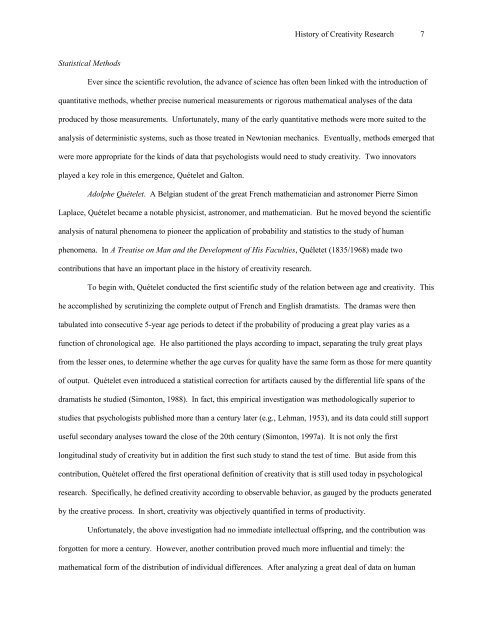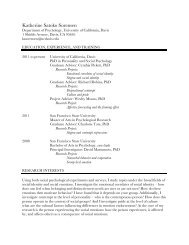The Psychology of Creativity:
The Psychology of Creativity:
The Psychology of Creativity:
Create successful ePaper yourself
Turn your PDF publications into a flip-book with our unique Google optimized e-Paper software.
History <strong>of</strong> <strong>Creativity</strong> Research 7<br />
Statistical Methods<br />
Ever since the scientific revolution, the advance <strong>of</strong> science has <strong>of</strong>ten been linked with the introduction <strong>of</strong><br />
quantitative methods, whether precise numerical measurements or rigorous mathematical analyses <strong>of</strong> the data<br />
produced by those measurements. Unfortunately, many <strong>of</strong> the early quantitative methods were more suited to the<br />
analysis <strong>of</strong> deterministic systems, such as those treated in Newtonian mechanics. Eventually, methods emerged that<br />
were more appropriate for the kinds <strong>of</strong> data that psychologists would need to study creativity. Two innovators<br />
played a key role in this emergence, Quételet and Galton.<br />
Adolphe Quételet. A Belgian student <strong>of</strong> the great French mathematician and astronomer Pierre Simon<br />
Laplace, Quételet became a notable physicist, astronomer, and mathematician. But he moved beyond the scientific<br />
analysis <strong>of</strong> natural phenomena to pioneer the application <strong>of</strong> probability and statistics to the study <strong>of</strong> human<br />
phenomena. In A Treatise on Man and the Development <strong>of</strong> His Faculties, Quéletet (1835/1968) made two<br />
contributions that have an important place in the history <strong>of</strong> creativity research.<br />
To begin with, Quételet conducted the first scientific study <strong>of</strong> the relation between age and creativity. This<br />
he accomplished by scrutinizing the complete output <strong>of</strong> French and English dramatists. <strong>The</strong> dramas were then<br />
tabulated into consecutive 5-year age periods to detect if the probability <strong>of</strong> producing a great play varies as a<br />
function <strong>of</strong> chronological age. He also partitioned the plays according to impact, separating the truly great plays<br />
from the lesser ones, to determine whether the age curves for quality have the same form as those for mere quantity<br />
<strong>of</strong> output. Quételet even introduced a statistical correction for artifacts caused by the differential life spans <strong>of</strong> the<br />
dramatists he studied (Simonton, 1988). In fact, this empirical investigation was methodologically superior to<br />
studies that psychologists published more than a century later (e.g., Lehman, 1953), and its data could still support<br />
useful secondary analyses toward the close <strong>of</strong> the 20th century (Simonton, 1997a). It is not only the first<br />
longitudinal study <strong>of</strong> creativity but in addition the first such study to stand the test <strong>of</strong> time. But aside from this<br />
contribution, Quételet <strong>of</strong>fered the first operational definition <strong>of</strong> creativity that is still used today in psychological<br />
research. Specifically, he defined creativity according to observable behavior, as gauged by the products generated<br />
by the creative process. In short, creativity was objectively quantified in terms <strong>of</strong> productivity.<br />
Unfortunately, the above investigation had no immediate intellectual <strong>of</strong>fspring, and the contribution was<br />
forgotten for more a century. However, another contribution proved much more influential and timely: the<br />
mathematical form <strong>of</strong> the distribution <strong>of</strong> individual differences. After analyzing a great deal <strong>of</strong> data on human
















